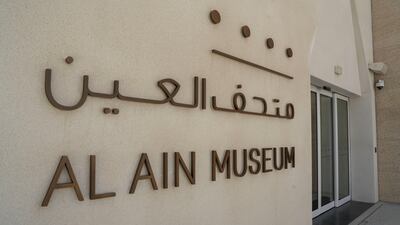More than five decades after Al Ain Museum was established by UAE Founding Father, the late Sheikh Zayed bin Sultan Al Nahyan, the restored and redeveloped attraction is set to offer visitors a renewed experience that connects the city to its rich history and cultural heritage.
The UAE’s first museum is to reopen to the public on October 24, and the renovation reflects Sheikh Zayed's enduring vision, says Omar Salem Al Kaabi, its director.
“Al Ain Museum was the vision of Sheikh Zayed, may God have mercy on him,” he says. “The government later decided to restore and renovate it so that it could continue its mission of preserving Al Ain’s history and identity.”
Founded in 1969, the museum originally occupied part of Sultan Fort, also known as the Eastern Fort, in what is now the museum district. A dedicated building was completed in 1971, and over the years, additional galleries were added.
Al Kaabi said the renovation has gone beyond simple restoration. “During restoration and excavation work, archaeological finds were discovered beneath the museum site,” he says. “The decision was made to preserve these discoveries and integrate them into the new museum experience so visitors can see them as part of the museum’s visitor route.”

These archaeological remains now feature alongside the permanent collections and many of the museum's original exhibits. Visitors will be able to view the artefacts and the underlying sites, highlighting the continuity of human life in the region, Al Kaabi says. Newly discovered items from current excavations in the Al Ain region have also been incorporated.
The museum’s narrative extends back to the Palaeolithic era – or Old Stone Age. “We have artefacts identified by archaeologists as dating back 300,000 years,” he says. “The collection continues through the Bronze Age, the Iron Age, and later periods up to the present day.”
The museum’s galleries are organised around themes including historical displays about Al Ain, archaeological sites and traditional heritage. Interactive features and services are designed to ensure an engaging, inclusive experience.
“Everything a visitor might need will be available – for all ages and abilities, including children, adults and people of determination,” Al Kaabi says. “From the moment they arrive to the end of their visit, they’ll have access to food areas, rest zones and interactive spaces designed especially for younger visitors.”

Al Kaabi highlights the museum’s role in connecting Al Ain to the UAE’s broader cultural outlook. “The new museums opening soon on Saadiyat Island are an extension of Sheikh Zayed’s vision – to preserve and showcase the UAE’s cultural heritage,” he says.
For its director, the museum is also about education and preservation. “Our visitors are very important to us – this museum is for them,” he says. “It allows them to learn about the region’s history through a rich and engaging experience. Through it, future generations can appreciate their heritage and ensure it is passed down.”
Al Kaabi adds: “Al Ain Museum is a place for preservation and learning. It is also a centre for archaeological study and research that deepens our understanding of the region’s history across different eras.”
At its core, Al Ain Museum remains faithful to Sheikh Zayed’s original vision: a space for conserving the past, educating the present and inspiring future generations.



